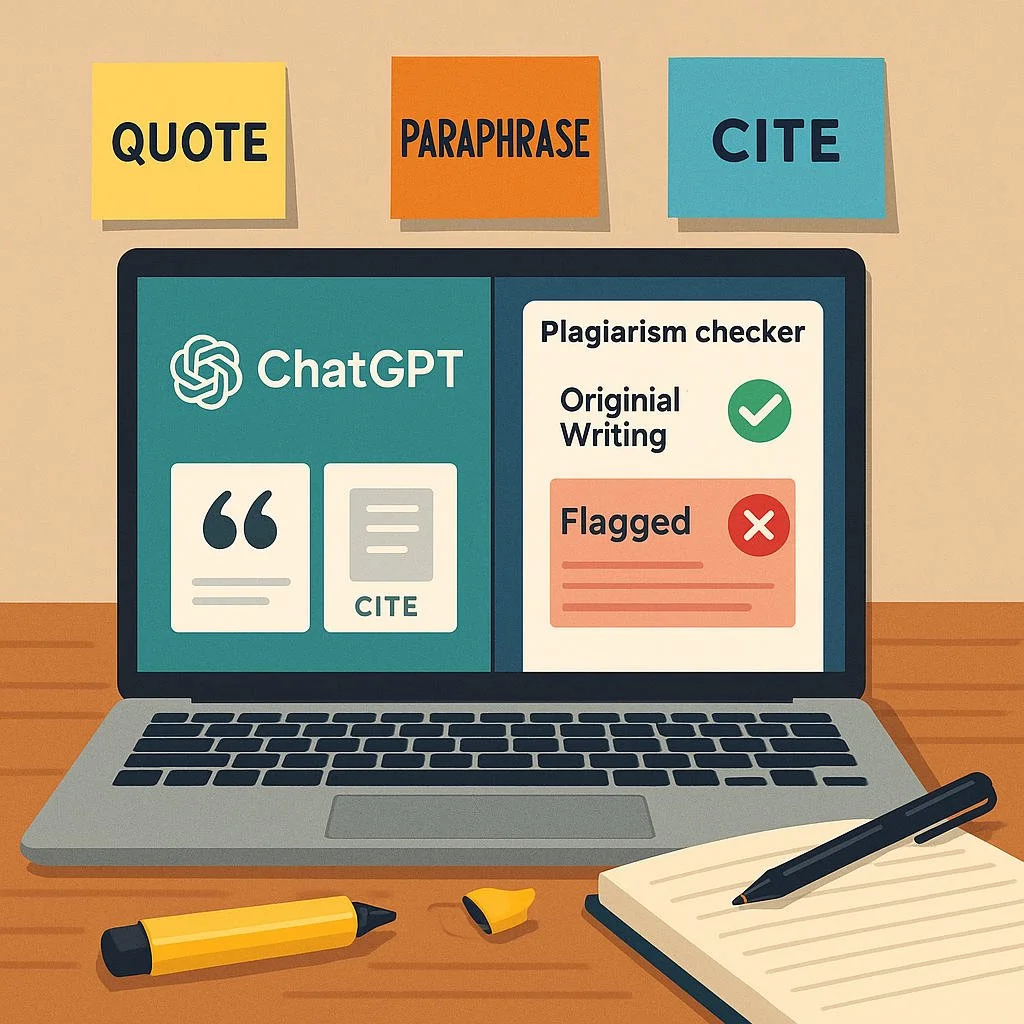How to Use ChatGPT to Avoid Plagiarism
How to Use ChatGPT to Avoid Plagiarism (2025 Guide)
The big idea
Plagiarism is about misrepresenting origin—passing off someone else’s words, structure, or unique ideas as your own. ChatGPT can help you think, outline, and draft—but you are responsible for:
Knowing where ideas come from,
Marking quotations and paraphrases properly, and
Giving credit when credit is due.
Use the model as a scaffolding tool, not a ghostwriter.
What counts as plagiarism (and what doesn’t)
Direct plagiarism: Copying phrases/sentences without quotation marks and citation.
Patchwriting: Swapping a few words in another author’s sentences while keeping the structure. Still plagiarism.
Paraphrase without attribution: Summarizing another person’s unique ideas with no citation.
Self-plagiarism: Reusing your prior work (class, journal, client) without disclosure/permission.
Data/code/media plagiarism: Using charts, datasets, images, or code without credit or license compliance.
Not plagiarism: Summarizing common knowledge (widely accepted facts), or producing original analysis informed by your sources with proper citations.
Your four guardrails (memorize these)
Provenance: Track where every idea/fact came from.
Quotation: Put others’ exact words in quotes with a citation.
Paraphrase: Rewrite ideas from scratch in your own structure and voice, then cite.
Disclosure: When rules require it (classroom, newsroom, client), say you used AI as a tool—and how.
A safe, repeatable workflow (the 10-step method)
Step 1 — Collect sources first (outside ChatGPT)
Read the originals. Take bullet notes in your own words. Mark exact quotes with quotation marks now, so you never forget what’s verbatim.
Step 2 — Build a Provenance Log
Create a simple list as you research:
Source ID, author, date
What’s unique insight vs common knowledge
Page or timestamp for every quote/claim
You’ll cite from this later.
Step 3 — Ask ChatGPT for structure, not sentences
Prompt:
“Given these notes, produce a clean outline with sections and talking points. Do not write full prose. Keep ideas grouped, highlight where evidence/citations are needed.”
This prevents copy-pasting ready-made paragraphs you didn’t author.
Step 4 — Draft in your own words
Write the first version yourself from your outline. Where you use an idea from a specific source, flag a citation placeholder immediately (e.g., [Source 3, p. 124]).
Step 5 — Use ChatGPT as a clarity editor, not a voice replacer
Prompts that are safe:
“Reduce wordiness in this paragraph; keep my structure and tone.”
“Highlight unclear sentences and suggest fixes; don’t invent facts.”
“Reorder for logic; keep my words wherever possible.”
Avoid prompts like “rewrite this entire chapter to sound brilliant,” which can lead you back toward patchwriting and misattribution.
Step 6 — Paraphrase the right way (two-pass method)
Close the source. Don’t look at it.
Explain the idea to ChatGPT as if to a friend, in your own words.
Reopen the source; compare: Is your structure and phrasing substantially different? If not, try again.
Add a citation anyway. Paraphrase ≠ no citation.
Safe prompt:
“Here’s my explanation of [concept] in my own words. Compare it to this original excerpt and tell me if any sentences are too close in structure or phrasing. Suggest rewrites that preserve meaning but not wording or order.”
Step 7 — Quote with precision
If a phrase is distinctive or perfect, quote it.
Use quotation marks and a citation.
If you trim a quote, use ellipses sparingly and square brackets for clarifications.
Prompt:
“Insert quotation marks around any verbatim language from this excerpt and format a brief citation note I can adapt.”
Step 8 — Summarize responsibly
When summarizing a whole article or chapter:
Use your own structure (new order of points).
State scope (“In a 2022 study, X argues…”).
Cite the source even if no direct quotes appear.
Prompt:
“Create a 100-word neutral summary of this source that keeps the author’s logic but changes the order and avoids unique wording. Add a note on what should be cited.”
Step 9 — Build citations and a bibliography
Ask for formatted references (APA/MLA/Chicago/IEEE), but verify details manually against your notes.
Prompt:
“From my Provenance Log, generate a reference list in [style]. Flag any missing fields so I can fill them.”
Step 10 — Run a self-audit before submission
Did I cite every non-common-knowledge claim?
Are all quotations marked?
Any paragraphs whose sentence order mirrors a source?
Did I disclose AI assistance if required by my institution or client?
Prompt:
“Audit this draft for plagiarism risks: patchwriting, absent citations, close paraphrases, distinctive terms reused. Output a checklist of fixes.”
What not to ask ChatGPT to do
“Write my paper on X with citations”—it may produce generic prose and mis-citations you’ll own.
“Paraphrase this paragraph” (and immediately paste it in)—that’s patchwriting risk.
“Blend these five sources into one paragraph”—easily collapses attribution.
Instead: ask for outlines, concept maps, argument trees, counterarguments, checklists, or questions that help you write your own text.
Examples: acceptable vs. risky paraphrases
Original idea (source’s sentence):
“Urban heat islands intensify nighttime temperatures by trapping heat in impervious surfaces, elevating heat stress among low-income residents.”
Risky patchwriting (too close):
“Urban heat islands raise nighttime temperatures by storing heat in impervious materials, increasing heat stress for low-income groups.”
—Same syntax and key phrases. Not okay.
Acceptable paraphrase (new structure/voice + citation):
“Because concrete and asphalt release heat slowly after sunset, some neighborhoods stay much warmer at night, which disproportionately affects poorer residents [Source A].”
Notice: different opening logic, different verbs, explicit citation.
Using ChatGPT for originality, not imitation
Generate questions, not paragraphs
Prompt:
“List ten research questions that challenge the prevailing view of [topic], sorted by feasibility. For each, note what kind of evidence would answer it.”
Map arguments and counterarguments
Prompt:
“Create a debate map on [claim]. Outline best arguments on both sides and the strongest counterpoints. Don’t write prose—give bullet points I can expand.”
Create analogy drafts to spark your own framing
Prompt:
“Offer three non-obvious analogies that could help a lay reader grasp [complex concept]. Keep them short; I’ll develop the one I choose.”
Citation rules in tricky areas
Common knowledge
If a fact appears in numerous standard sources (e.g., “Water boils at 100 °C at sea level”), no citation needed.
When in doubt, cite.
Ideas vs. facts
Unique interpretations, frameworks, or models require citation even if you rewrote them.
Statistics always need a source (and date/context).
Visuals, figures, and tables
If you reproduce or adapt a figure/table, include “Adapted from [source]” and ensure you have rights to do so.
For charts created from someone else’s data, cite the dataset and methodology.
Code and datasets
Respect licenses. Comment headers should attribute original authors, versions, and licenses.
For tiny idioms/snippets (e.g., a common regex), credit isn’t typically required, but larger blocks are.
Prompt:
“Generate attribution headers for these code files based on my notes (authors, licenses). Add TODO markers for any missing license info.”
AI disclosure: when and how
Academic settings: Many courses now require a short AI use statement describing which steps were AI-assisted (e.g., outlining, grammar suggestions).
Journalism/marketing: Follow your org’s policy. If transparency is required, add a line in your process memo or footer.
Client work: If your contract restricts AI, don’t use it—or get written permission first.
Prompt:
“Draft a two-sentence AI use disclosure: tools used, tasks (outline, clarity edits), and a statement that all claims/quotes were verified and cited.”
Self-plagiarism (yes, it’s a thing)
Don’t resubmit your old assignment/article without approval.
If reusing sections, disclose and get permission; cite your prior work if policy requires it.
For research, journals often require cross-reference to earlier preprints or conference versions.
Prompt:
“Compare Draft A (2023) and Draft B (2025) and list any identical or near-identical passages so I can revise or disclose reuse.”
Role-specific playbooks
Students
Use ChatGPT for outlines, question lists, and clarity edits.
Keep a Provenance Log and export your citations at the end.
Ask for a rubric check: “Grade this draft against the rubric; point to any claim that needs a source.”
Researchers
Ask for related-work maps and gap lists; never accept autogenerated citations blindly.
Use the model to propose method section checklists and threats to validity.
Journalists
Use ChatGPT to craft interview question lists, story structures, and ethics checks.
All facts must be verified through primary sources or on-record interviews.
Marketers
Feed it briefs, personas, product facts; have it propose angles.
Never lift competitor copy; run a similarity scan against your own prior campaigns to avoid unintentional reuse.
Engineers
Use for boilerplate, test ideas, or doc outlines.
Keep license compliance and attributions in code comments.
Ask for security/architecture review checklists instead of pasting stackoverflow answers verbatim.
Prompts you can paste today
Provenance Log starter
“From these notes, create a table with Source ID, author, year, page/time, key idea, quote (if any), and whether it’s common knowledge or unique.”
Patchwriting detector
“Compare my paragraph to this source excerpt. Identify sentences too close in structure/wording. Suggest rewrites preserving meaning only.”
Citation audit
“Scan this draft and flag any claim likely to require a citation. Insert [CITE] notes with the likely source from my log.”
Voice consistency
“Edit for clarity and flow while preserving my tone. Do not add facts or examples. Track changes inline.”
AI use statement
“Write a transparent 2-sentence note describing how I used ChatGPT (outline, clarity edits), that I verified all claims, and that I’m responsible for content.”
A quick “plagiarism-safe” checklist (final pass)
Quotes are in quotation marks with citations.
Paraphrases use new structure and phrasing + citation.
Every statistic/claim has a source or is common knowledge.
Figures/tables/code have attribution and license notes.
Self-reuse is disclosed if applicable.
AI use is disclosed if required by policy.
I can explain every sentence out loud without reading.
Troubleshooting (why drafts still fail originality checks)
“It sounds generic/AI-ish.”
Ask for a voice pass in your style and add specific detail (numbers, names, places) drawn from your own experience.
“Similarity score is high.”
Look for structure echoes—not just words. Change the order of ideas, swap metaphors, write from a different angle.
“I paraphrased but got flagged.”
You likely kept the source’s syntax. Close the source and rewrite from your notes. Cite anyway.
“My citations are wrong.”
You copied a placeholder or hallucinated reference. Replace with entries from your Provenance Log only.
One-hour clean workflow (from messy notes to safe draft)
0–10 min: Build outline with ChatGPT (no prose).
10–25 min: Write your own first draft from notes; drop [CITE] where needed.
25–40 min: Paraphrase checks on risky paragraphs; add quotes where exact phrasing is essential.
40–50 min: Generate and verify references from your Provenance Log.
50–60 min: Run a final audit (patchwriting/citation/voice), add AI disclosure if required.
TL;DR (finally)
Treat ChatGPT as a thinking and editing assistant, not a content source.
Keep a Provenance Log, mark quotes, and paraphrase with new structure and wording—then cite.
Use prompts that produce outlines, questions, and audits, not ready-made paragraphs to paste.
Disclose AI use when policies require it; verify every claim and reference yourself.
If you can explain every sentence in your own words, with sources at hand, you’re using ChatGPT ethically—and safely.








